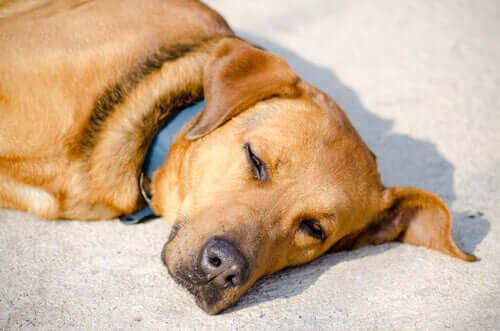Dandruff in Dogs: Causes and Treatment


Written and verified by the lawyer Francisco María García
Like with humans, dandruff in dogs is basically a group of dead cells that fall from the skin. It often looks like those famous small white flakes. However, there are also cases where it looks more like scales on your dog’s skin or fur.
In fact, there are also other potential symptoms associated with this condition. The most common with dandruff in dogs are small bumps on its skin. You may also see scabs of various sizes on its skin, and it may start to lose hair.
Dandruff generally happens in dogs as a result of dry skin. That being said, fat is another potential cause. There are also some breeds that are especially prone to dry skin, like German shepherds. Other breeds, like Labradors, frequently develop fatty skin.
In any case, the first step for you is always to figure out the root cause of your dog’s dandruff. If you don’t do that, it’s going to be very hard to provide it with the right treatment.
Causes of dandruff in dogs
Dandruff has lots of potential causes in dogs. It could start as a result of poor hygiene, a dry environment, nutrient deficiencies, infections, or allergies. The specific cause of your dog’s case will determine the kind of treatment you need to provide.

Here are some of the most frequent causes:
- Poor hygiene routines. This can mean several different things. For example, not bathing your dog enough can be a problem, but so can bathing it too often. Or, in some cases, people use products that aren’t good for dogs, like human shampoo or low-quality soaps.
- A dry climate. Dry parts of the world are a big cause of dandruff in dogs. It’s an especially big problem in the winter.
- Nutrient deficiencies. Low levels of omega-3 fatty acids can have a major impact on your dog’s skin and can lead to dryness.
- Bacterial and fungal infections. In this case, the dandruff will usually also involve blisters that pop and form crusty scabs.
- In some cases, dandruff can be caused by allergens like pollen, home cleaning products, chemicals, and other substances.
- Mites. The Cheyletiella mite can cause dandruff in dogs too. It causes a specific kind of scaliness known as “walking dandruff” (cheyletiellosis). The name comes from the fact that the mites move around, making it look like the dandruff is moving too.
In general, dandruff isn’t a major health problem. This means that no treatment will be too intense. However, if the cause is something like a fungus, bacteria, or mite, you might need to take your dog to the vet.
Remedies for dandruff in dogs
As we mentioned earlier, the treatment you provide will depend on the cause. If you determine that the cause is poor hygiene, you simply need to improve your routines. Your vet can tell you how often to bathe your dog, based on its breed. They can also help you find the right shampoo for its skin and fur.
It’s always a good idea to brush your dog. This simple act will actually stimulate its skin’s natural oil production, helping eliminate the dandruff.
If the problem is a dry climate, the best thing you can do (outside of moving) is to buy a humidifier. This is especially important to have during the winter months.

If the dandruff is a result of some nutrient deficiency, you should change its diet to include more zinc and vitamin A and E. Foods with fish oils are also important for this.
Dandruff that comes from bacteria, fungi, or mites will require veterinary treatment. In most cases, they’ll have to provide some form of medication. But you can still help. Regardless of which of the three is causing it, you should wash all the bed sheets with hot water and vacuum all your rugs and furniture.
Home remedies
If your dog’s case of dandruff isn’t too severe, you may be able to solve it with home remedies. The advantage of these is that they’re very gentle and don’t have side effects. Plus, they tend to be very cheap.
One of the best home remedies for dandruff in dogs is apple cider vinegar. The recipe is simple: mix it with equal parts of water, then rub your dog’s skin with a rag or cloth soaked in the vinegar-water mix. You should do this once a day until the dandruff goes away.
Olive oil is also a great home remedy for dandruff. All you need to do is rub your dog’s skin and fur with it once a day, like the other treatment.
As always, though, prevention is the best way to deal with these kinds of problems. Make sure you’re bathing and brushing your dog often enough, and if your dog still gets dandruff, apply the tips in this article!
This text is provided for informational purposes only and does not replace consultation with a professional. If in doubt, consult your specialist.